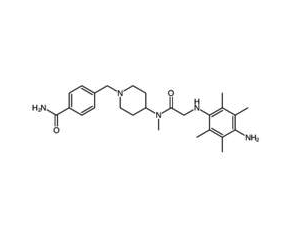
SUN 11602
CAS No. 704869-38-5
SUN 11602( SUN11602 | SUN-11602 | SUN 11602 )
Catalog No. M19020 CAS No. 704869-38-5
SUN11602, an aniline compound, mimics the neuroprotective mechanisms of basic fibroblast growth factor.
Purity : >98% (HPLC)
 COA
COA
 Datasheet
Datasheet
 HNMR
HNMR
 HPLC
HPLC
 MSDS
MSDS
 Handing Instructions
Handing Instructions
| Size | Price / USD | Stock | Quantity |
| 5MG | 50 | In Stock |


|
| 10MG | 87 | In Stock |


|
| 25MG | 178 | In Stock |


|
| 50MG | 295 | In Stock |


|
| 100MG | 368 | In Stock |


|
| 200MG | Get Quote | In Stock |


|
| 500MG | Get Quote | In Stock |


|
| 1G | Get Quote | In Stock |


|
Biological Information
-
Product NameSUN 11602
-
NoteResearch use only, not for human use.
-
Brief DescriptionSUN11602, an aniline compound, mimics the neuroprotective mechanisms of basic fibroblast growth factor.
-
DescriptionSUN11602 is a novel aniline compound, which mimics the neuroprotective mechanisms of basic fibroblast growth factor. In primary cultures of rat cerebrocortical neurons, SUN11602 and bFGF prevented glutamate-induced neuronal death.
-
In VitroSUN11602 prevents glutamate-induced neuronal death in primary cultures of rat cerebrocortical neurons. SUN11602 increases the levels of CALB1 gene expression in cerebrocortical neurons. SUN11602 exerts protective effects on hippocampal neurons through activation of FGFR1 and increases CalB expression. SUN11602 promotes neurite outgrowth of primarily cultured rat hippocampal neurons.
-
In VivoIn WT mice, SUN11602 increases the levels of newly synthesized Calb in cerebrocortical neurons and suppresses the glutamate-induced rise in intracellular Ca2+. This Ca2+-capturing ability of Calb allows the neurons to survive severe toxic conditions of glutamate. Oral administration of SUN11602 at the midpoint of Aβ1-40 and ibotenate injections attenuate short-term memory impairment in the Y-maze test, as well as spatial learning deficits in the water maze task. In addition, the SUN11602 treatment inhibits the increase of peripheral-type benzodiazepine-binding sites (PTBBS),which are a marker for gliosis.
-
SynonymsSUN11602 | SUN-11602 | SUN 11602
-
PathwayOthers
-
TargetOther Targets
-
RecptorERK1| ERK2| FGFR
-
Research Area——
-
Indication——
Chemical Information
-
CAS Number704869-38-5
-
Formula Weight451.61
-
Molecular FormulaC26H37N5O2
-
Purity>98% (HPLC)
-
SolubilityDMSO : ≥ 37 mg/mL; 81.93 mM
-
SMILESC(=O)(c1ccc(cc1)CN1CCC(CC1)N(C)C(=O)CNc1c(c(c(c(c1C)C)N)C)C)N
-
Chemical Name4-((4-(2-((4-amino-2,3,5,6-tetramethylphenyl)amino)-N-methylacetamido)piperidin-1-yl)methyl)benzamide
Shipping & Storage Information
-
Storage(-20℃)
-
ShippingWith Ice Pack
-
Stability≥ 2 years
Reference
1. Murayama, et al. ACS Chem.Neurosci. 4 266.
molnova catalog



related products
-
Glutathione synthesi...
Glutathione synthesis-IN-1 (DC-1) is an inhibitor of glutathione synthesis.
-
AF-2, nematode
AF-2, nematode
-
Vindolinine
Vindolinine is a natural product from Catharanthus roseus (L.) G. Don.



 Cart
Cart
 sales@molnova.com
sales@molnova.com


